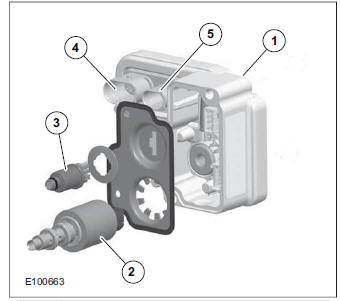 Ford Kuga Service ManualRear Drive Axle/Differential » Rear Drive Axle and Differential (System Operation and Component
Description)
Ford Kuga Service ManualRear Drive Axle/Differential » Rear Drive Axle and Differential (System Operation and Component
Description)
All-wheel drive control unit
All-wheel drive control unit

| Item | Description |
| 1 | Electronic Control Unit |
| 2 | Control valve |
| 3 | Pressure/temperature sensor |
| 4 | Electrical connection CAN (controller area network) databus |
| 5 | Electric feed pump connection |
The all-wheel drive control unit is bolted directly to the housing of the Haldex clutch.
It forms one unit made up of the control valve, a pressure/temperature sensor, and a control module. It receives signals from the PCM and from the ABS control module via the CAN data bus. The control module in the control unit uses these signals to determine the fluid pressure that is needed to actuate the clutch plates depending on the requirement. This determines how much torque should be transmitted to the rear wheels. All-wheel drive is deactivated if a fault occurs in the all-wheel drive control unit.
A preload of approx. 80 Nm is always present at the Haldex clutch.
The temperature sensor of the Haldex clutch is installed near the control valve in the control unit and is surrounded by the hydraulic fluid. The temperature is transmitted to the control module and is used for adaptation to the changing viscosity of the hydraulic fluid. If the hydraulic fluid is cold, the control valve has to be opened slightly more than requested. This allowance has to be reduced as the temperature increases. The normal working temperature of the hydraulic fluid is between +40 C and +60 C. If the temperature rises above 100 C, the clutch is depressurised; if the temperature falls below 95 C, the clutch is pressurised again.
All-wheel drive is deactivated and a diagnostic trouble code set if a fault occurs in the temperature sensor.
With Haldex Generations I and II, the control valve was actuated via a stepper motor. With Haldex Generation III, the stepper motor has been omitted.
The control valve is now actuated via a solenoid valve. The solenoid valve is actuated by the control module in the all-wheel drive control unit by means of pulse width modulation. The pulse width modulation determines the position of the adjustment spindle and thus the opening cross section of the return hole. This is how the pressure at the working piston of the plates is determined.
If the return hole is fully closed, maximum pressure is applied to the plates. If the return hole is fully open, the plates are unpressurized.
General Information
Driving situations
Haldex clutch
Design of the 3rd generation Haldex clutch
Design of the multi-plate clutch
All-wheel drive control unit
Electric feed pump
Pressure control - 3rd generation Haldex clutch
Base pressure
Increased base pressure (preload)
Pressure build-up
Design of the 4th generation Haldex clutch
Pressure control - 4th generation Haldex clutch
Ford Kuga Service Manual
- General Information
- Jacking and Lifting
- Noise, Vibration and Harshness
- Suspension System - General Information
- Climate Control
- Auxiliary Climate Control
- Instrument Cluster and Panel Illumination
- Instrument Cluster
- Horn
- Warning Devices
- Parking Aid
- Charging System - General Information
- Battery, Mounting and Cables
- Generator and Regulator
- Voltage Converter/Inverter
- Information and Entertainment System - General Information
- Information and Entertainment System
- Exterior Lighting
- Interior Lighting
- Daytime Running Lamps (DRL)
- Module Communications Network
- Module Configuration
- Wiring Harnesses
- Anti-Theft - Active
- Anti-Theft - Passive
- Multifunction Electronic Modules
- Front End Body Panels
- Body Closures
- Interior Trim and Ornamentation
- Exterior Trim and Ornamentation
- Rear View Mirrors
- Seating
- Glass, Frames and Mechanisms
- Instrument Panel and Console
- Handles, Locks, Latches and Entry Systems
- Wipers and Washers
- Bumpers
- Safety Belt System
- Supplemental Restraint System
- Body Repairs - General Information
- Body Repairs - Vehicle Specific Information and Tolerance Checks
- Front End Sheet Metal Repairs
- Roof Sheet Metal Repairs
- Side Panel Sheet Metal Repairs
- Rear End Sheet Metal Repairs
- Paint - General Information
- Uni-Body, Subframe and Mounting System
- Suspension System - General Information
- Front Suspension
- Rear Suspension
- Wheels and Tires
- Driveshaft
- Rear Drive Axle/Differential
- Front Drive Halfshafts
- Rear Drive Halfshafts
- Brake System - General Information
- Front Disc Brake
- Rear Disc Brake
- Parking Brake and Actuation
- Hydraulic Brake Actuation
- Power Brake Actuation
- Anti-Lock Control
- Anti-Lock Control - Stability Assist
- Steering System - General Information
- Power Steering
- Steering Linkage
- Steering Column
- Steering Column Switches
- Engine System - General Information
- Engine- 2.5L Duratec (147kW/200PS) - VI5
- Engine Cooling
- Fuel Charging and Controls-2.5L Duratec (147kW/200PS) - VI5
- Fuel Charging and Controls - Turbocharger- 2.5L Duratec (147kW/200PS) - VI5
- Accessory Drive - 2.5L Duratec (147kW/200PS) - VI5
- Starting System- 2.5L Duratec (147kW/200PS) - VI5
- Engine Ignition - 2.5L Duratec (147kW/200PS) - VI5
- Engine Emission Control - 2.5L Duratec (147kW/200PS) - VI5
- Intake Air Distribution and Filtering - 2.5L Duratec (147kW/200PS) - VI5
- Evaporative Emissions
- Electronic Engine Controls
- Automatic Transmission/Transaxle
- Transmission/Transaxle Cooling
- Automatic Transmission/Transaxle External Controls
- Transfer Case
- Exhaust System-
- Fuel System
- Fuel Tank and Lines
- Acceleration Control
- Speed Control
- Climate Control System
- Climate Control
Main Categories
0.0171
